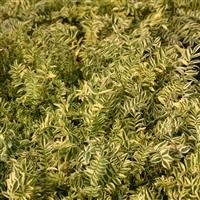

Narrative Description:
This was a naturally occurring mutation that was discovered growing on a nursery in France. It is an erect, clump-forming perennial with typical "Jacob's Ladder" compound, pinnate leaves. Leaves are bright green variegated with golden-creamy-white edges. Cup-shaped, violet-sky blue flowers appear drooping from flowering stems in spring.
Ideal Conditions:
Prefers full sun and free-draining soil or compost.
Possible Situation:
Ideal for woodland gardens.
Resilience:
Hardy Perennial (H4 -10°C to -5°C)
Habit:
Upright
Height x Spread / Trail:
40 x 30 cm
Features:
Typical Season:
Spring
Flower Colour:
Foliage Colour:
Green
Cream
Flowering Time:
April - May
Planting Recommendations:
Bed/Border
Prefers:
Part Sun
Temperature Tolerance:
A hardy plant which should survive normal winter conditions outside, especially if protected from the hardest frosts.
Plant Care:
Prune after flowering to rejuvinate and promote further flowers.
Family:
POLEMONIACEAE
Genus:
Polemonium
Species:
caeruleum
Cultivar:
Brise D' Anjou
UPOV:
BLANJOU
UPOV No:
EUPVR 1718
Category:
Hardy Perennials
Recommended Pot Sizes:
11cm
1Ltr
3Ltr+
Pot Spacing:
Leave enough room so that foliage does not overlap within crop time.
Typical time required from pot to sale:
26 weeks over Winter
10 weeks in Spring / Summer
Based on producing a finished pot size of 1L for plug products and 2L for liner products. (*)
Growing Media / Irrigation / Water Capacity:
Free draining - keep evenly moist
Feeding / Fertilser
(during crop time):
NPK balanced feeding
Feeding Frequency:
Requires normal/regular feeding (Standard EC)
Recommended pH:
Standard 5.0 to 5.5
Growth Regulation PGR:
Due to the current approval situation, please contact your PGR provider
Temperature During Production:
Cool crop 4 - 12°C
Temperature During Transport:
12-16°C
Available for Delivery:
February - June
Recommended Sales Window:
April - November
Forecast Availability:
| Wk/Yr: | 18/26 | 23/26 |
|---|---|---|
| Qty: | 16 | 16 |
Please note: this forecasted availability is a guide only. Quantities can be increased or produced earlier on request.
Common Pests:
Aphid
Common Diseases:
Botrytis
Powdery Mildew
| 50 Plants / Tray | 50 Plants / Tray | 50 Plants / Tray |
| 50 Plants / Tray | 50 Plants / Tray |
Additional Notes (*):
All information provided is based on producing a default finished pot size of 1L for our plug products, and 2L for 7cm and 9cm liner products. For alternative pot sizes please adjust cultural notes accordingly.
Finishing times - Based on average estimated climatic and environmental conditions, and are for guidance purposes only.
Temperature – These conditions assume a protected ornamental growing environment. Recommended growing is generally above 5°C.
Feeding – Does not specify controlled release or liquid fertiliser application. This choice will depend on your conditions, requirements and preferences – please contact your fertiliser consultant for suitable products to meet your requirements.
Growing media and pH – Is shown for guidance purposes only - please contact your growing media consultant for suitable growing media to meet your requirements.
Disclaimer
This information is for guidance purposes only and is based upon our own growing environment and experience during trials. It is wise to use your own knowledge about your growing conditions and local environment in order to make informed cultural decisions.